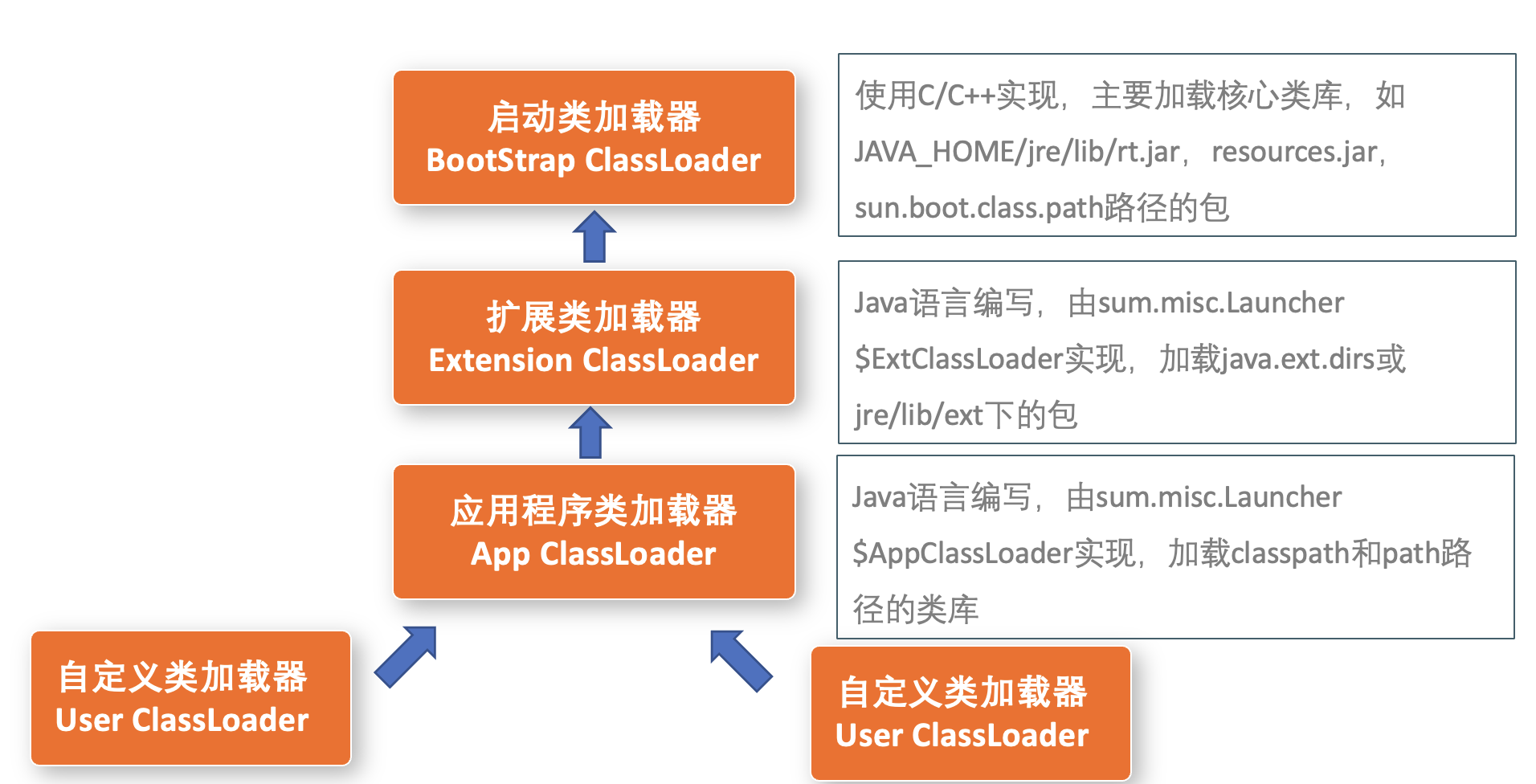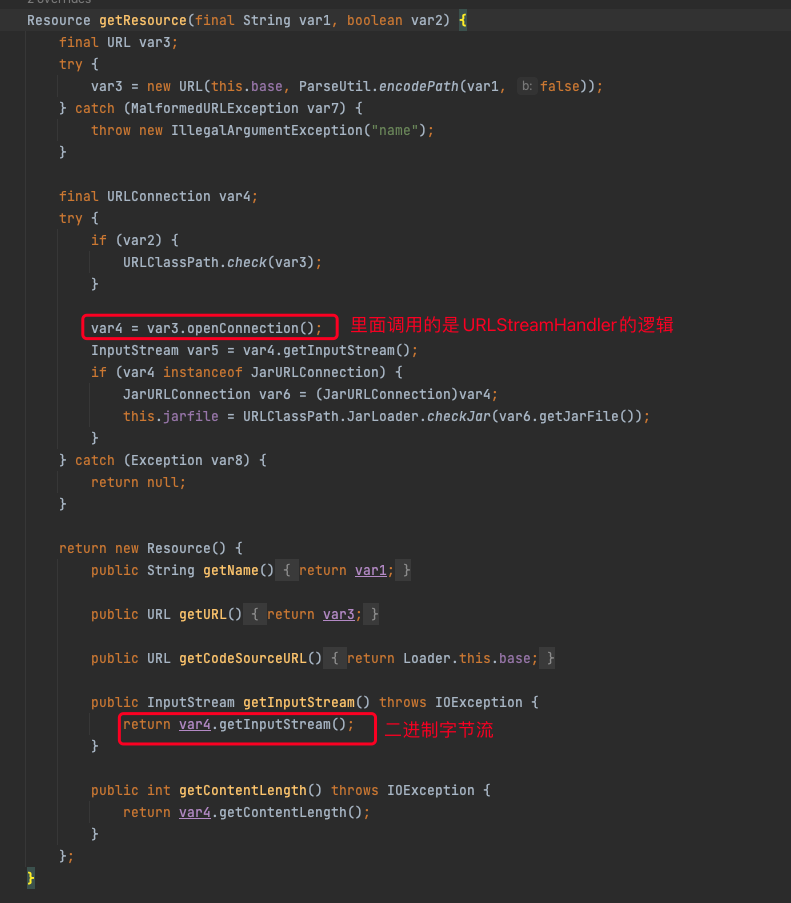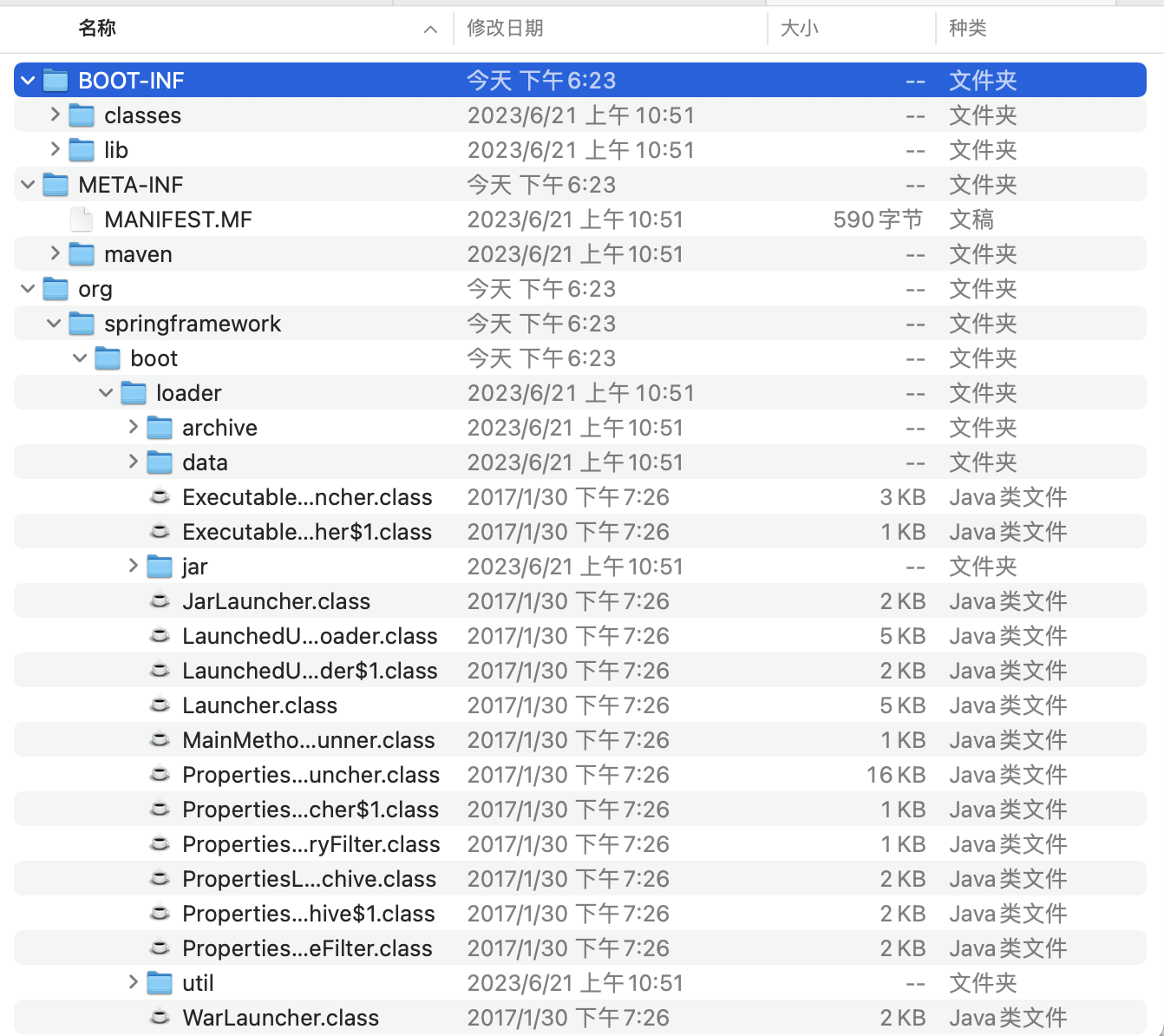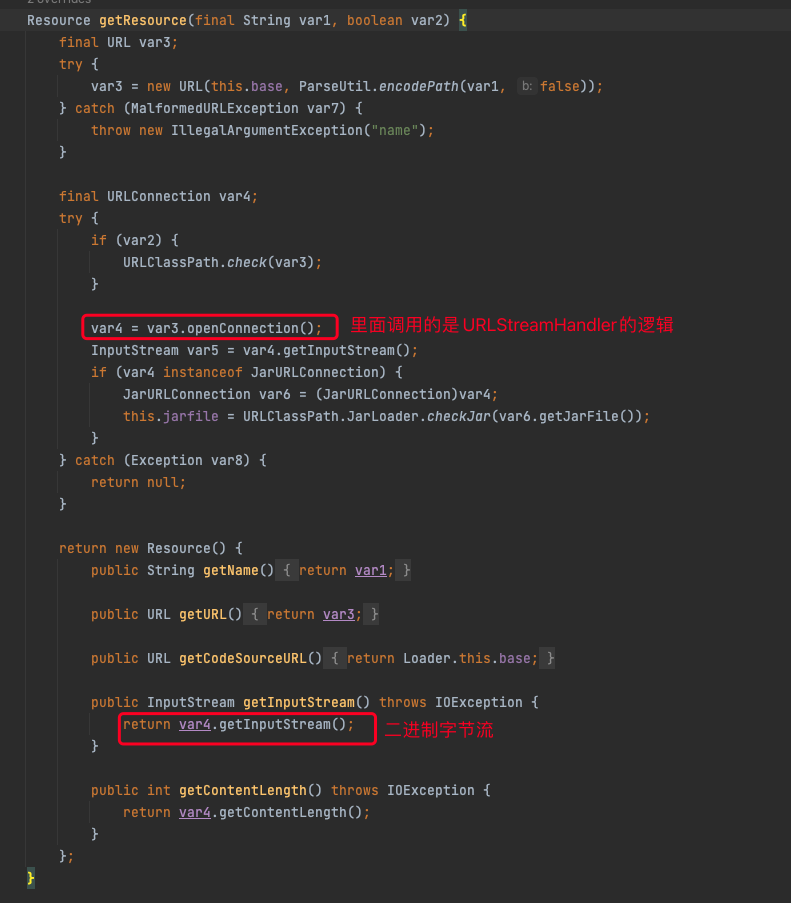前言
本文将从源码角度介绍SpringBoot是如何自定义ClassLoader去加载FatJar的,以及FatJar又是如何读取jar里面嵌套jar中的类,中间会涉及到一些ClassLoader的知识。
类加载器基础知识
双亲委托机制
双亲委托指的是加载一个类的时候,先由父类加载器去加载,如果父类加载器在加载的目录加载不到,再由子加载器加载,这样做的目的是保证同一个类只加载一次。

- BootStrap Classloader : 启动类加载器,主要加载核心的类库
- Extension ClassLoader : 扩展类加载器,在java.ext.dirs或jre/lib/ext下
- Application ClassLoader : 即AppClassLoader,应用程序类加载器,普通的Java启动项目就是AppClassLoader加载
<p>一些容器都是基于AppClassLoader去扩展自定义的ClassLoader,以AppClassLoader作为父类加载器做的扩展,比如Tomcat使用的是WebAppClassLoader,SpringBoot使用的是LaunchedURLClassLoader。 </p>
另外我们自定义的ClassLoader,一般都是基于AppClassLoader去扩展的。
双亲委托指的是ClassLoader对象(ClassLoader实例),而不是ClassLoader类的继承,它是一种对象成员来实现双亲委托的,ClassLoader加载类的源码loadClass方法如下:
protected Class<?> loadClass(String name, boolean resolve)
throws ClassNotFoundException
{
synchronized (getClassLoadingLock(name)) {
// 加载过的类不再加载
Class<?> c = findLoadedClass(name);
if (c == null) {
long t0 = System.nanoTime();
//从父类加载器加载
try {
if (parent != null) {
c = parent.loadClass(name, false);
} else {
c = findBootstrapClassOrNull(name);
}
} catch (ClassNotFoundException e) {
}
if (c == null) {
//父类加载器找不到,调用findClass方法
long t1 = System.nanoTime();
c = findClass(name);
// this is the defining class loader; record the stats
sun.misc.PerfCounter.getParentDelegationTime().addTime(t1 - t0);
sun.misc.PerfCounter.getFindClassTime().addElapsedTimeFrom(t1);
sun.misc.PerfCounter.getFindClasses().increment();
}
}
if (resolve) {
resolveClass(c);
}
return c;
}
}
首先判断是否加载过类,如果没有加载过,由父类加载,如果父类加载不到,会调用findClass方法。
URLClassLoader
URLClassLoader类如其名,主要是加载一些URL资源比如class和jar包等,可以复用URLClassLoader去扩展自己的ClassLoader,事实上Tomcat和SpringBoot也是这样做的。
URL是什么?
指一种资源,包括但不限为class文件,jar包,甚至是自定义的文件。
URL是怎么处理字节流的呢?
既然URL可以是任意文件或者资源,那读取的文件的方式也不一样
我们翻开URL.openConnection函数,可以看到是由URLStreamHandler handler处理的逻辑
public URLConnection openConnection() throws java.io.IOException {
return handler.openConnection(this);
}
这样扩展的URL就可以通过重写URLStreamHandler类实现URL的自定义加载逻辑,事实上SpringBoot的FatJAR也是这样做的。
而URLConnection中有一个getInputStream函数
public InputStream getInputStream() throws IOException;
返回的是二进制字节流,有了InputStream就能构建资源和类了。
URLClassLoader的来龙去脉
URLClassLoader是ClassLoader的一个派生类,通过addURL可以加载jar包
protected void addURL(URL url) {
ucp.addURL(url);
}
而ucp就是URLClassPath,管理着所有添加的URL。
URLClassLoader符合双亲委托机制,重写了findClass方法来查找Class。
protected Class<?> findClass(final String name)
throws ClassNotFoundException
{
final Class<?> result;
try {
result = AccessController.doPrivileged(
new PrivilegedExceptionAction<Class<?>>() {
public Class<?> run() throws ClassNotFoundException {
String path = name.replace('.', '/').concat(".class");
Resource res = ucp.getResource(path, false);
if (res != null) {
try {
return defineClass(name, res);
} catch (IOException e) {
throw new ClassNotFoundException(name, e);
}
} else {
return null;
}
}
}, acc);
} catch (java.security.PrivilegedActionException pae) {
throw (ClassNotFoundException) pae.getException();
}
if (result == null) {
throw new ClassNotFoundException(name);
}
return result;
}
里面是从Resource res = ucp.getResource(path, false);获取到资源类的,ucp就是上文的URLClassPath。
进去 ucp.getResource 方法,可以看到getResource的实现细节,就是我上面说的URL的加载

SpringBoot加载FatJar的原理
FatJar结构
解压一个SpringBoot项目的的jar包,可以看到FatJar结构

BOOT-INF 是工程打包的文件,BOOT-INF/classes存放的是工程的代码和配置文件,BOOT-INF/lib存放的是依赖的嵌套jar包(即jar in jar)。
org.springframework.boot.* 是SpringBoot启动类
打开META-INF/MANIFEST.MF,可以看到jar包的启动类
Manifest-Version: 1.0
Implementation-Title: LittleBoy
Implementation-Version: 1.0-SNAPSHOT
Archiver-Version: Plexus Archiver
Built-By: liubs
Implementation-Vendor-Id: com.thanple.little.boy
Spring-Boot-Version: 1.5.1.RELEASE
Implementation-Vendor: Pivotal Software, Inc.
Main-Class: org.springframework.boot.loader.JarLauncher
Start-Class: com.thanple.little.boy.web.WebApplication
Spring-Boot-Classes: BOOT-INF/classes/
Spring-Boot-Lib: BOOT-INF/lib/
Created-By: Apache Maven 3.6.3
Build-Jdk: 1.8.0_191
Implementation-URL: http://projects.spring.io/spring-boot/LittleBoy/
Main-Class是Jar包的启动类,org.springframework.boot.loader.JarLauncher, Start-Class就是你写的项目启动的主函数
FatJar并不是一个标准的jar包结构,只有org.springframework.boot才是符合jar包标准的,BOOT-INF目录下的都是无法加载的,因此SpringBoot需要自定义加载器。
SpringBoot启动加载类流程
刚才提到的org.springframework.boot.loader.JarLauncher,就是SpringBoot真正的启动主函数,那跟本地写的main函数类(假设为WebApplication)有什么区别呢? 普通的本地main函数,没有嵌套的Jar,是由AppClassLoader直接加载启动,而SpringBoot则是自己写了一套类加载器LaunchedURLClassLoader。
JarLauncher的main函数作为入口,创建实例调用了Launcher.launch函数
public static void main(String[] args) throws Exception {
new JarLauncher().launch(args);
}
Launcher.launch进入可以看到创建了一个LaunchedURLClassLoader,由LaunchedURLClassLoader去加载FatJar中的class和jar嵌套的jar(即jar in jar)。
protected void launch(String[] args) throws Exception {
if (!this.isExploded()) {
JarFile.registerUrlProtocolHandler();
}
//加载URL,由LaunchedURLClassLoader加载
ClassLoader classLoader = this.createClassLoader(this.getClassPathArchivesIterator());
String jarMode = System.getProperty("jarmode");
String launchClass = jarMode != null && !jarMode.isEmpty() ? "org.springframework.boot.loader.jarmode.JarModeLauncher" : this.getMainClass();
this.launch(args, launchClass, classLoader);
}
//创建LaunchedURLClassLoader
protected ClassLoader createClassLoader(URL[] urls) throws Exception {
return new LaunchedURLClassLoader(this.isExploded(), this.getArchive(), urls, this.getClass().getClassLoader());
}
然后在this.launch(args, launchClass, classLoader)里面使用LaunchedURLClassLoader调用自己写的主函数WebApplication
public class MainMethodRunner {
//...
public void run() throws Exception {
Class<?> mainClass = Class.forName(this.mainClassName, false, Thread.currentThread().getContextClassLoader());
Method mainMethod = mainClass.getDeclaredMethod("main", String[].class);
mainMethod.setAccessible(true);
mainMethod.invoke((Object)null, this.args);
}
}
这里反射调用自己写的主函数WebApplication的main函数,这样就完成了一套加载的流程。
完整的流程链路如图所示:

LaunchedURLClassLoader
LaunchedURLClassLoader作为SpringBoot加载FatJar的主要类加载器,继承了URLClassLoader,重写了loadClass方法,但是这个类看不到多少核心的逻辑。
@Override
protected Class<?> loadClass(String name, boolean resolve) throws ClassNotFoundException {
if (name.startsWith("org.springframework.boot.loader.jarmode.")) {
try {
Class<?> result = loadClassInLaunchedClassLoader(name);
if (resolve) {
resolveClass(result);
}
return result;
}
catch (ClassNotFoundException ex) {
}
}
if (this.exploded) {
return super.loadClass(name, resolve);
}
Handler.setUseFastConnectionExceptions(true);
try {
try {
definePackageIfNecessary(name);
}
catch (IllegalArgumentException ex) {
// Tolerate race condition due to being parallel capable
if (getPackage(name) == null) {
// This should never happen as the IllegalArgumentException indicates
// that the package has already been defined and, therefore,
// getPackage(name) should not return null.
throw new AssertionError("Package " + name + " has already been defined but it could not be found");
}
}
return super.loadClass(name, resolve);
}
finally {
Handler.setUseFastConnectionExceptions(false);
}
}
里面区分了org.springframework.boot.loader.jarmode和其他jar区别,定义了包名, 核心的逻辑还是调用了super.loadClass,就是URLClassLoader.loadClass。
URLClassLoader.loadClass就是上面的加载的URL的流程,那么FatJar和普通的Jar是怎么区分逻辑的呢?
所有的不同在于Launcher.launch中的加载URL的流程中:
ClassLoader classLoader = this.createClassLoader(this.getClassPathArchivesIterator());
ExecutableArchiveLauncher中可以看到getClassPathArchivesIterator的逻辑
protected Iterator<Archive> getClassPathArchivesIterator() throws Exception {
Archive.EntryFilter searchFilter = this::isSearchCandidate;
Iterator<Archive> archives = this.archive.getNestedArchives(searchFilter, (entry) -> {
return this.isNestedArchive(entry) && !this.isEntryIndexed(entry);
});
if (this.isPostProcessingClassPathArchives()) {
archives = this.applyClassPathArchivePostProcessing(archives);
}
return archives;
}
其中getNestedArchives获取了FatJar中的jar包(jar in jar)中的归档信息,BOOT-INF/classes和BOOT-INF/lib/*.jar,每个元素都作为一个Archive,返回一个迭代器列表。
FatJar的加载
SpringBoot在org.springframework.boot.loader.jar中重新定义了(确切的说应该是扩展)jar的实现,包括JavaFile,JavaEntry,JarURLConnection等。
this.archive.getNestedArchives一路深入进去查看源码,可以看到JarFile里面有个函数
private JarFile createJarFileFromEntry(org.springframework.boot.loader.jar.JarEntry entry) throws IOException {
return entry.isDirectory() ? this.createJarFileFromDirectoryEntry(entry) : this.createJarFileFromFileEntry(entry);
}
BOOT-INF/classes作为一个目录会构造一个JavaFile,而BOOT-INF/lib/*.jar则作为嵌套jar(jar in jar)则会构造另一个JavaFile
那么这个嵌套Jar(jar in jar)又是如何读取数据的呢?
我们在JavaFile.createJarFileFromFileEntry中可以找到逻辑
private JarFile createJarFileFromFileEntry(org.springframework.boot.loader.jar.JarEntry entry) throws IOException {
if (entry.getMethod() != 0) {
throw new IllegalStateException("Unable to open nested entry '" + entry.getName() + "'. It has been compressed and nested jar files must be stored without compression. Please check the mechanism used to create your executable jar file");
} else {
RandomAccessData entryData = this.entries.getEntryData(entry.getName());
return new JarFile(this.rootFile, this.pathFromRoot + "!/" + entry.getName(), entryData, JarFile.JarFileType.NESTED_JAR);
}
}
其中entries就是指的外层FatJar的每一条数据,比如BOOT-INF/lib/a.jar,BOOT-INF/lib/b.jar,作为jar in jar,先获取这个jar in jar中的RandomAccessData数据流。
然后通过RandomAccessData数据流再构造一个JavaFile,这样就可以将构造的Jar in jar进行数据读取和访问了。
jar in jar 的路径大概长这样:
LittleBoy-1.0.jar!/BOOT-INF/lib/a.jar
LittleBoy-1.0.jar!/BOOT-INF/lib/b.jar
LittleBoy-1.0.jar!/BOOT-INF/lib/c.jar
而JavaFile获取到的URL就是可以由URLClassLoader加载的URL
public URL getUrl() throws MalformedURLException {
if (this.url == null) {
String file = this.rootFile.getFile().toURI() + this.pathFromRoot + "!/";
file = file.replace("file:////", "file://");
this.url = new URL("jar", "", -1, file, new Handler(this));
}
return this.url;
}
这里返回URL的时候 new 了一个Handler来实现URLStreamHandler处理URL的逻辑。
我们打开这个Handler的源码,org.springframework.boot.loader.jar.Handler
可以看到获取URLConnection的处理逻辑
protected URLConnection openConnection(URL url) throws IOException {
if (this.jarFile != null && this.isUrlInJarFile(url, this.jarFile)) {
return JarURLConnection.get(url, this.jarFile);
} else {
try {
return JarURLConnection.get(url, this.getRootJarFileFromUrl(url));
} catch (Exception var3) {
return this.openFallbackConnection(url, var3);
}
}
}
获取到的JarURLConnection中有getInputStream方法返回查找的字节流。
返回这个字节流是如何加载到LaunchedURLClassLoader中的呢?
前面已经说了LaunchedURLClassLoader继承了URLClassLoader,根据URL返回的字节流,就可以根据ClassName获取到Resource, 以下是URLClassLoader.getResource方法

而这个Resource,就可以defineClass,即定义一个类
以下代码摘自URLClassLoader.findClass
protected Class<?> findClass(final String name)
throws ClassNotFoundException
{
//省略部分代码
...
String path = name.replace('.', '/').concat(".class");
Resource res = ucp.getResource(path, false);
if (res != null) {
try {
return defineClass(name, res);
} catch (IOException e) {
throw new ClassNotFoundException(name, e);
}
} else{
return null;
}
}
至此,已经把一个FatJar的加载流程全部阐述完了。
雷军公布小米澎湃 OS 完整系统架构,称底层全部重构 语雀 10 月 23 日故障原因及修复过程公告 微软 CEO 纳德拉:放弃 Windows Phone 和移动业务是错误决策 Java 11 和 Java 17 使用率均超 Java 8 Hugging Face 被限制访问 语雀网络故障持续大约 10 小时,现已恢复正常 Oracle 推出 Visual Studio Code 的 Java 开发扩展 国家数据局正式揭牌 马斯克:如果维基百科改名“维鸡百科”就捐款 10 亿美元 MySQL 8.2.0 GA